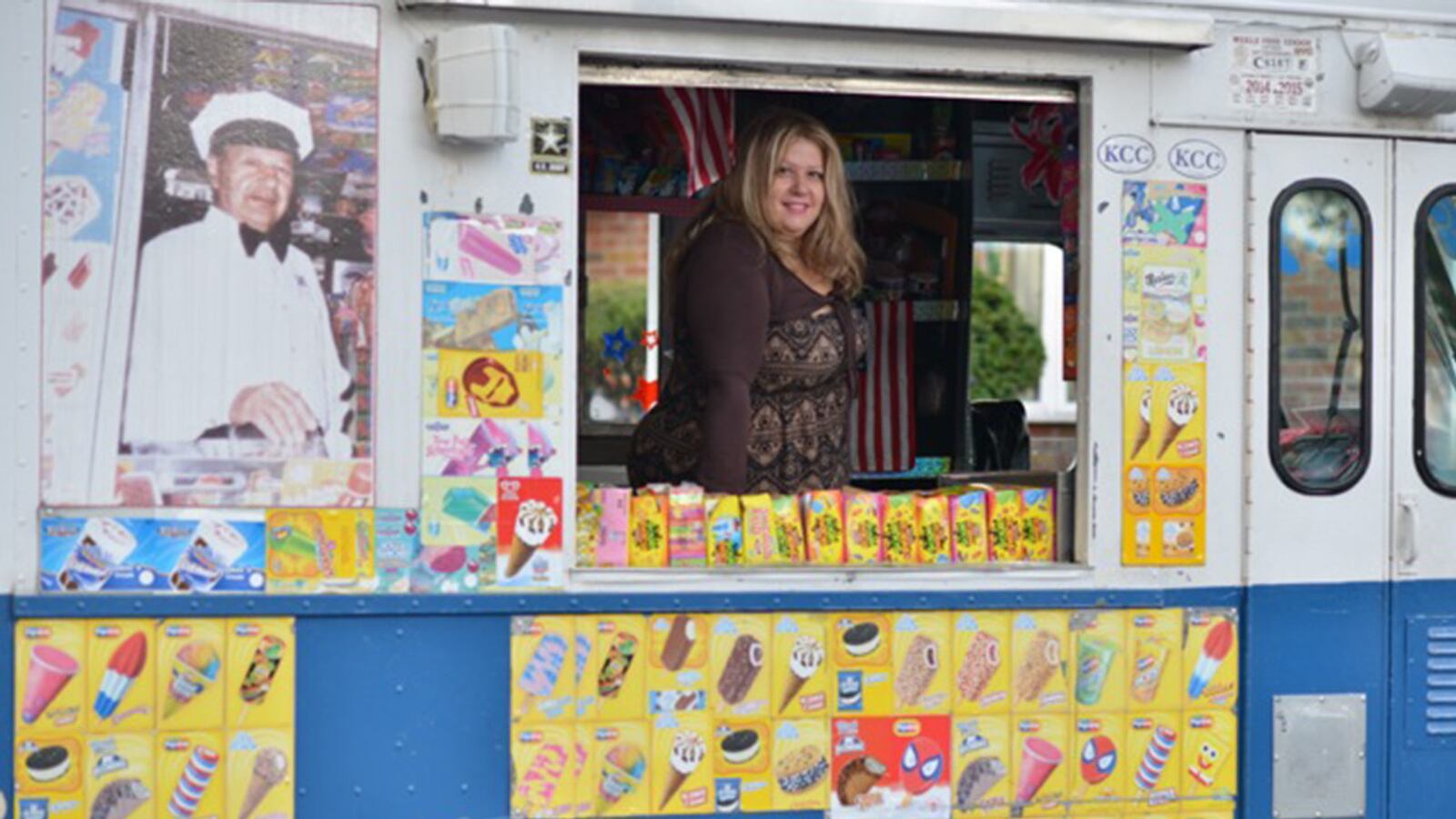From Brooklyn’s first, greatest, and likely last Italian ice cream girl comes a demonstration of daughterly devotion to cheer you in these dark days of Ebola and ISIS.
And as we come to Columbus Day, Maria “The Ice Cream Girl” Campanella’s triumphant five-year struggle to have a street named after her father comes as further proof that being Italian American is not synonymous with The Godfather and organized crime but with daddy and honest, hard work.
No street signs in Brooklyn bear the name of a gangster, but thanks to Maria there is one at 21st Avenue and what has until now just been 77th Street that reads:
“Angelo ‘Chubby’ Campanella Way.”
When Maria began her campaign back in 2009, city officials told her that streets in New York are only named after prominent personages or heroes who have sacrificed their lives. Her father served in World War II, but he was not a general and he did not win the Medal of Honor and he was not among our honored dead.

His true greatness began after he traded his Army uniform for that of a Good Humor man.
He soon became a familiar figure on the streets of Bensonhurst in his white hat, white pants, and white shirt, black bow tie, a gleaming silver change-maker on his belt. He started with a pushcart and graduated to a bicycle cart, and then one of those Good Humor trucks whose bells brought children running.
He acquired the nickname Chubby when he weighed in at 225 pounds, and it stuck even after he dieted down to 150. One generation and then another grew up with Chubby as the happy harbinger of summer.
He never tired of warning them to watch out for cars when they crossed the street. He was known to refuse to sell to kids unless they went to school. He was always ready to spare a kid the embarrassment of not having enough for an ice cream while his friends slurped away.
“When there’s a kid who’s just a little short of change, you know that kid’s going to get an ice cream,” a community leader would recall.
The whole ice cream business was rocked in 1975, when the Brooklyn district attorney handed down an 244-count indictment charging that Good Humor had knowingly sold ice cream that the Air Force had rejected as contaminated to a home for boys. The scandal drove the company from the street business, but Chubby acquired a truck of his own.
Many of the others who did the same were also men of Italian extraction. They purchased their ice cream from wholesalers on McDonald Avenue, where a non-Italian neutral party settled disputes over whose routes extended where. None of them worked longer hours than did Chubby.
“I used to wait up for him every night to come home late from work, and I used to sit there and watch him eat and admire him, because I knew he worked hard because he loved us,” Maria remembers. “He was my dad, and to what seemed like the rest of the world he was Chubby the Ice Cream Man, and I wanted to be just like him.”

She describes a childhood in which she was a particular kind of celebrity:
“He used to drive me to school in his ice cream truck. I was famous for that. He used to deliver ice cream to my classes. I was famous for that. My birthday parties always had an ice cream truck parked outside. I was famous for that. I never had to wait for an ice cream truck to stop and pay for ice cream. Mine was always free, free, free!”
Maria became rebellious in the way of many teenage girls, but where another father might have despaired, Chubby knew just what to do. And in doing it, he broke a gender barrier.
“I was 19 years old,” Maria says. “Chubby the Ice Cream Man, my dad, gave me a chance and put me on his ice cream truck. ‘Why would he do that?’ I asked myself. ‘Why would he want me, of all people, on his truck, in his business, something he had built with his customers who totally admired him and were so close, like family to him?’”
The answer transformed her:
“Because he believed in me. He knew something about me that I didn’t. He knew I could be so much more. He trusted me. So I trusted him, and he was right.”
She goes on, “That very first day I became The Ice Cream Girl, not so common back then in an Ice Cream Man’s world. And I was The Ice Cream Girl, leading the way.”
Like other great pioneers, she took to heart what she had learned from the finest of those who preceded her.
“I’ve learned from the best, my dad, the old timers, the gentlemen’s crew,” she says. “Where respect and kindness and of course ‘safety first’ are always our main priorities.”
At night, when trouble might have otherwise beckoned to a young woman her age, Maria was in the truck, working. Her father worked days.
To the distress of father and daughter, the orderly ways of ice cream in Brooklyn turned chaotic with the incursion of Russian and Middle Eastern immigrants who interpreted freedom in America to include selling ice cream wherever your truck takes you.
At the same time, Chubby experienced growing heart troubles, finally becoming too disabled to work in 2004. He was housebound as Maria continued working the route.
But in 2006, as he was turning 80, Chubby acquired a motorized wheelchair. He proceeded to prove that the right spirit can turn a disability into a blessing.
As Maria set out to begin another day in the ice cream truck, Chubby would roll alongside her for part of the route. He would then veer away wherever inspiration led him, he and Maria exchanging a look that said everything without anybody saying anything.
“It was always the look,” she recalls. “Then he’d just go.”
Off he zipped, the CD player in his lap playing Tony Bennett or one of the songs that Maria wrote and recorded, these including “Daddy, I Love You.” He carried an extension cord in case he needed to recharge at one of his emergency spots.
“A gas station on 74th Street,” Maria recalls. “A bank on 18th Avenue, a firehouse.”
He set off in every kind of weather.
“Snow, ice,” Maria says. “I used to scream at him, ‘Please, Dad, don’t go out!’ He’d say, ‘What am I going to do—sit down all day and do nothing? There’s things I want to do. I want to be out there.’ I was so scared, but I just wanted him to be free, happy. He had a life after working so many years.”
She told the neighbors that he was only doing what was best for him.
“Everybody used to say we should stop him from doing this and keep him home. I would just say, ‘Let him go, he’s happy.’”
He would take in a parade or maybe stop by a senior center. He was known to traverse Brooklyn to visit somebody a decade older than himself in a nursing home. Any relative in the hospital was sure to get a visit. He would then go and check on the relative’s kids and assure them that all was well. He would load his chair with groceries and other purchases, once a 30-roll package of toilet paper.
Sometimes he was out in his wheelchair as late at night as he had once been in his truck. His wife, Rita, would wait and pray until she would hear the bicycle squeeze horn he had affixed to the chair.
“He would beep, beep, beep, and I would go, ‘Thank you, dear God, thank you, Blessed Mother, thank you, everybody up there, for sending him home,’” Rita says.
The next day, he would be off again. Maria managed to get reports on his whereabouts by putting a small white flag on the back of the wheelchair that said “The Ice Cream Girl Maria.”
“Customers tell me, ‘I seen some man with your name on his wheelchair!’ ‘I seen your father in Coney Island!’ ‘I seen your father in Bay Ridge!’” Maria recalls. “It was like a GPS.”
On May 27, 2009, Chubby returned from his latest adventures. He fell ill early the next morning and died after being taken to the hospital. He was 83.
At the wake, Maria parked the wheelchair next to the coffin, the CD player in the seat as if he were ready to roll. She ordered a floral display in the shape of a huge ice cream bar with a single bite taken out of it.
Maria continued to sell ice cream along the route, even as the trouble from the interloping trucks was compounded by a continuing exodus of neighborhood people who had cherished Chubby and the Ice Cream Girl.
“Times, people, and places have changed, along with different lifestyles and customs,” Maria says. “But I refuse to let my dad’s legacy end.”
And she wanted to do more than keep her father’s business going. She also wanted to keep his memory alive. She decided that it would only be right to have the street where he lived and kept his truck named after him.
The city insisted that such honors are reserved for people like the firefighters and cops who perished in the 9/11 attacks. Maria suggested that there are other kinds of heroes, including a man who dedicated his life to his family and his neighborhood and made himself part of the fabric of the community where he lived. And a man who then demonstrated that a wheelchair can be a chariot.
A number of elected officials, including City Council Member David Greenfield, City Council Member Mark Treyger, former City Council Member Domenic Recchia, and state Sen. Marty Golden, agreed. They joined the fight.
“It’s like the canonization of a saint these days to get a block named,” one of the officials notes.

Maria and her allies kept pushing. The final hurdle was a longtime city policy against nicknames in street signs.
“I said, ‘You got to put in ‘Chubby,’” Greenfield recalls. “They said, ‘Why?’ I said, “Or nobody’s going to know who is it is.’”
The formal unveiling was held Oct. 5. Maria made sure it was done in the best Brooklyn style; bigger-than-life photos of Chubby, lanyards holding small photos of him along with a red heart, a red carpet, Mylar balloons, two kids dressed up as ice cream, a 10-year-old prodigy vocalist named Diana Marie Paunetto to sing the “Star-Spangled Banner,” a hot DJ, and of course a biplane that flew overhead towing a banner:
“CHUBBY… DADDY I LOVE YOU… MARIA THE ICE CREAM GIRL.”
The speakers included a man who had been struck by a hit-and-run driver who had then been chased down by Chubby. The man also recalled how Chubby would spare him the embarrassment of finding himself without a coin when all the other kids went running up to the truck.
“My mother’s money ran out before the week did,” he remembered. “[But] I got an ice cream like everybody else.”
As the actual unveiling neared, Greenfield spoke of Mara’s effort to make it possible. She was one person who had fought City Hall and won.
“This is what you call perseverance, ladies and gentlemen,” Greenfield said.
After a dramatic countdown from 10, Maria pulled a string and a sleeve came off the new street sign reading “Angelo ‘Chubby’ Campanella Way.”
“The street pole that tells a wonderful story,” Maria told the assemblage. “The story of my wonderful dad.”






